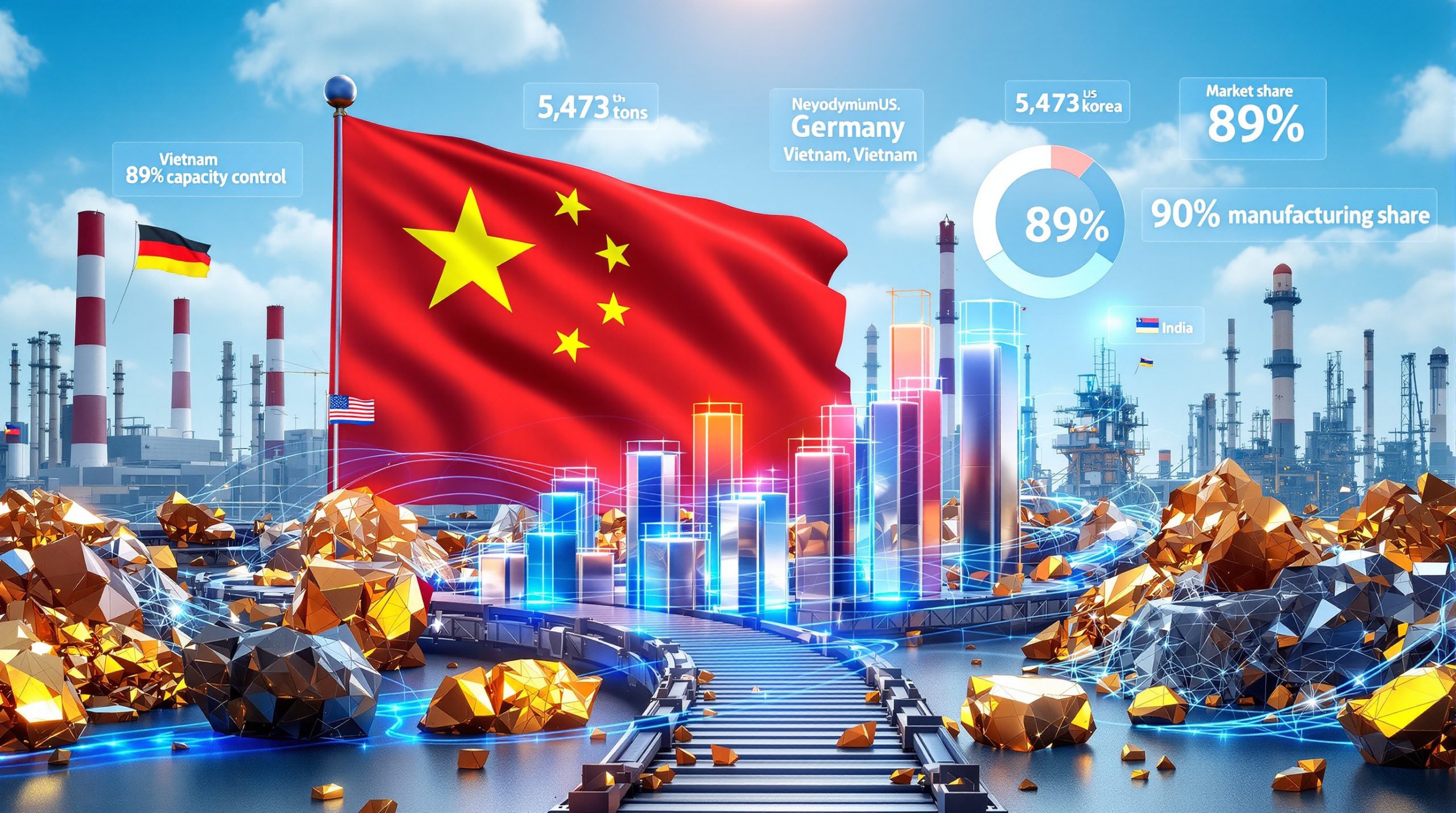The rare earth industry stands at a technological inflection point where traditional supply chain fragmentation meets urgent strategic imperatives. While global manufacturing has historically relied on specialised regional nodes for different processing stages, geopolitical tensions and supply security concerns are driving unprecedented vertical integration efforts. This transformation centres around mine-to-magnet capacity development, where single operators control the entire value chain from ore extraction through finished permanent magnet production.
Understanding these integrated production systems requires examining the industrial engineering challenges, operational bottlenecks, and economic realities that determine whether vertically integrated facilities can compete with established fragmented supply chains. The stakes extend beyond commercial viability to encompass national security, technological sovereignty, and the foundation of next-generation manufacturing capabilities.
Understanding Mine-to-Magnet Integration and Its Strategic Value
Mine-to-magnet capacity represents a complete industrial ecosystem encompassing every stage from raw ore processing to finished permanent magnet manufacturing. This integrated approach contrasts sharply with the historically fragmented global supply chain, where different countries and companies specialised in specific processing stages.
The complexity of this integration becomes apparent when examining the technical interdependencies between processing stages. Rare earth oxide purity levels directly influence downstream separation efficiency, while separation performance constrains metal production capacity. Each stage requires distinct expertise, from geological engineering and hydrometallurgy to precision alloy manufacturing and magnetic materials science.
Critical Processing Stage Requirements
| Stage | Primary Function | Critical Equipment | Typical Capacity Bottlenecks |
|---|---|---|---|
| Mining | Ore extraction | Crushers, flotation cells | Geological grade variability |
| Separation | Chemical purification | Solvent extraction circuits | Heavy REE recovery rates |
| Metallisation | Metal production | Reduction furnaces | Energy costs and purity |
| Alloying | Magnetic material creation | Induction melting | Composition consistency |
| Manufacturing | Magnet production | Sintering presses | Quality control standards |
The strategic importance of vertical integration stems from supply chain vulnerability reduction and quality control optimisation. Traditional fragmented supply chains face coordination challenges, inventory management complexities, and geopolitical exposure at multiple nodes. Integrated operations can optimise material flows, reduce quality variations, and maintain production continuity during supply disruptions.
Material processing losses compound across stages, typically ranging from 40-60% from raw ore to finished magnets depending on ore grade and recovery efficiency. Integrated facilities can optimise these losses through closed-loop recycling, process parameter coordination, and waste stream monetisation across multiple stages.
Global Mine-to-Magnet Capacity Distribution Analysis
China dominates global permanent magnet production with an estimated 85-90% market share across all magnet types, operating extensive integrated production networks developed over three decades. Chinese state-owned enterprises have systematically built vertical integration from mining operations through magnet manufacturing, creating cost advantages and supply chain control that remains unmatched globally.
Current Global Capacity Assessment
Chinese Production Infrastructure:
- Estimated 200,000+ metric tons annual NdFeB magnet capacity
- Integrated operations across multiple provinces
- State-owned enterprise coordination enabling cross-subsidisation
- Dominance in heavy rare earth processing from ionic clay deposits
Non-Chinese Capacity Distribution (2025):
| Region | Annual Capacity (MT) | Primary Companies | Integration Level |
|---|---|---|---|
| United States | ~1,000 | MP Materials (expanding) | Mining + separation |
| Japan | ~8,000 | Shin-Etsu Chemical | Magnet manufacturing |
| Europe | ~3,000 | Various manufacturers | Component assembly |
| Australia/Malaysia | Variable | Lynas Corporation | Mining + separation |
The capacity deficit outside China represents approximately 95% dependence on Chinese production for global permanent magnet supply. This concentration creates systemic vulnerabilities for industries requiring high-performance magnets, including electric vehicles, renewable energy systems, and defence applications.
Recent industry analysis indicates that Western mine-to-magnet capacity development faces fundamental challenges beyond simple scale-up. Technical expertise concentration in Asia, regulatory compliance costs, and capital intensity requirements create barriers that traditional market mechanisms struggle to overcome without strategic intervention. Furthermore, the west scrambles to fill heavy rare earth gap as China rivalry deepens.
Technical Challenges in Integrated Production Development
The most significant technical constraint in building mine-to-magnet capacity involves heavy rare earth element availability and processing economics. Dysprosium and terbium, essential for high-performance magnets, occur in minimal concentrations in most rare earth deposits outside China's ionic clay resources.
Heavy Rare Earth Processing Complexity
Bastnaesite deposits, which form the foundation of most non-Chinese rare earth projects, typically contain less than 0.1% heavy rare earth elements by total rare earth oxide content. This creates fundamental challenges for integrated operations seeking to produce high-performance magnets requiring 5-8% dysprosium content for optimal magnetic properties.
Technical Processing Considerations:
- Separation circuit complexity: Heavy REE recovery requires additional processing stages
- Chemical consumption: Higher acid and solvent requirements for trace element extraction
- Energy intensity: Increased power consumption for complex separation chemistry
- Quality control: Maintaining purity specifications across expanded product range
Current industry evidence suggests that scaling meaningful heavy rare earth production from bastnaesite sources remains commercially unproven. Recovery rates, separation economics, and competitive positioning versus Chinese ionic clay operations lack independent validation for most Western projects.
Metallurgical Integration Challenges
Successful mine-to-magnet operations require precise control across multiple metallurgical processes with different optimal operating conditions. Critical process parameters include:
- Separation purity requirements exceeding 99.9% for magnet-grade oxides
- Alloy composition tolerances within ±0.1% for magnetic property consistency
- Sintering atmosphere control below 10 ppm oxygen for performance optimisation
- Multi-layer coating systems for corrosion resistance and durability
The technical workforce required for integrated operations spans diverse specialisations from hydrometallurgy and pyrometallurgy to magnetic materials engineering. Skills gap analysis indicates limited availability of experienced personnel outside established production regions, requiring 10-15 year development timelines for senior technical capability.
Economic Factors Influencing Integration Viability
Mine-to-magnet facility development requires substantial capital investment across multiple technical disciplines, with estimated costs ranging from $200,000-300,000 per metric ton of annual magnet production capacity for fully integrated operations.
Capital Investment Structure
Integrated Facility Cost Components:
| Facility Component | Capacity | Capital Requirement | Cost per MT Capacity |
|---|---|---|---|
| Mining Infrastructure | 50,000 MT ore | $500-800 million | Variable by geology |
| Separation Processing | 5,000 MT REO | $200-400 million | $40,000-80,000 |
| Magnet Manufacturing | 1,000 MT magnets | $100-200 million | $100,000-200,000 |
| Integrated Complex | 10,000 MT magnets | $2,000-3,000 million | $200,000-300,000 |
Operating cost structures vary significantly by geographic location and energy availability. Western operations face labor cost premiums of 300-400% compared to Chinese facilities, while environmental compliance requirements add 5-10% to total operating costs.
Energy consumption represents a critical economic factor, with separation plant operations requiring 5-8 MWh per ton of REO produced. Chinese facilities benefit from lower-cost energy infrastructure, creating 10-20% cost advantages before considering labour or regulatory differentials.
Strategic Pricing Mechanisms
Recent developments in strategic material procurement include government price floor mechanisms designed to support domestic production. The U.S. Department of Defense has established $110/kg price floors for neodymium-praseodymium oxide under 10-year supply agreements, representing 30-50% premiums over historical market pricing.
These pricing interventions attempt to neutralise potential predatory pricing strategies while providing investment certainty for capacity development. However, effectiveness against broader economic retaliation remains unproven under actual geopolitical stress conditions. Consequently, understanding the broader implications of us‑china trade strategies becomes essential.
Technology Innovation in Capacity Expansion
Advanced separation technologies represent critical enablers for mine-to-magnet capacity development, with breakthrough innovations focused on improving heavy rare earth recovery rates and reducing processing complexity.
Next-Generation Processing Technologies
Continuous ion exchange systems demonstrate potential for reducing processing time by 40% compared to traditional batch solvent extraction. These technologies enable more compact facility footprints while improving separation efficiency for trace heavy rare earth elements.
Selective precipitation techniques show promise for improving heavy REE recovery from bastnaesite and other light-REE dominant ores. Laboratory-scale results indicate potential 15-25% improvements in dysprosium and terbium extraction rates, though commercial-scale validation remains incomplete.
Manufacturing Process Advancement
Emerging manufacturing innovations include:
- Additive manufacturing for complex magnet geometries requiring minimal machining
- Grain boundary engineering techniques enhancing coercivity without additional dysprosium
- Integrated recycling systems reducing virgin material requirements by 15-20%
- Automated quality control reducing variation in magnetic properties
Recycling integration represents a critical technology component for sustainable mine-to-magnet operations. Current industry estimates suggest that magnet recycling could supply 10-15% of rare earth demand by 2030, though economic viability requires scaled collection and processing infrastructure.
Corporate Integration Strategies and Implementation
MP Materials represents the most advanced Western mine-to-magnet integration initiative, with systematic expansion from mining through planned magnet manufacturing. Their development approach demonstrates both the potential and challenges of vertical integration in the rare earth sector.
Integrated Development Models
MP Materials' Strategic Progression:
- Mountain Pass mine operations: 50,000 MT/year REO capacity
- Texas separation facility: Operational since 2022 for light REE processing
- Planned Fort Worth magnet facility: Target 1,000 MT initial capacity
- Projected expansion to 10,000 MT annual magnet capacity by 2028
This development timeline demonstrates the complexity of scaling integrated operations, with multi-year gaps between facility commissioning and full operational capacity. Technical integration between stages requires extensive testing and optimisation periods.
Alternative Development Approaches:
Lynas Corporation operates a different model, focusing on mining and separation while supplying processed materials to downstream manufacturers. This approach reduces capital requirements and technical risk while maintaining exposure to market volatility.
USA Rare Earth's Round Top project represents an integrated design approach, planning mine-to-magnet capacity from project inception rather than sequential development. This model offers potential cost advantages through optimised facility design but requires larger upfront capital commitments.
Strategic Partnership Integration
Recent developments include unprecedented government-industry partnerships designed to support integrated capacity development. Public-private collaboration models feature:
- Long-term supply contracts with defence agencies
- Loan guarantees and equity investments from strategic partners
- Technology sharing agreements with allied nations
- Joint development programs for critical infrastructure
These partnerships attempt to address market failures in strategic material supply while distributing commercial risks between public and private stakeholders. In addition, European initiatives like the critical raw materials facility aim to strengthen regional supply chains.
Supply Chain Risk Assessment Framework
Geographic concentration vulnerabilities represent the primary driver for mine-to-magnet capacity development, with 95% of heavy rare earth supply originating from Chinese ionic clay deposits. This concentration creates systemic exposure for industries requiring high-performance permanent magnets.
Critical Dependency Analysis
Current Supply Chain Vulnerabilities:
- 85% of separation capacity concentrated in China
- Limited alternative heavy REE processing infrastructure globally
- Technical workforce expertise primarily located in established production regions
- Processing technology intellectual property concentrated among few companies
Risk Scenario Modelling indicates that supply disruptions lasting 6-12 months could create material shortages for critical applications including defence systems, renewable energy infrastructure, and electric vehicle production.
Workforce and Technical Capability Gaps
Developing integrated mine-to-magnet capacity requires specialised technical expertise across multiple disciplines. Current workforce analysis reveals:
- Limited academic programmes for rare earth metallurgy and processing
- Concentration of experienced personnel in existing production regions
- 10-15 year timelines required for developing senior technical staff
- Knowledge transfer challenges from proprietary industrial processes
These human capital constraints represent potentially binding limitations on the pace of capacity development, regardless of available financial resources or political support. Moreover, the evolution towards more sophisticated mining industry evolution requires new skillsets.
Government Policy Influence on Capacity Development
Strategic material security concerns have prompted unprecedented government intervention in rare earth supply chain development. Policy frameworks now include direct financial support, regulatory facilitation, and long-term procurement commitments designed to catalyse private investment.
U.S. Strategic Initiative Framework
Defence Production Act Authorities provide mechanisms for priority material allocation and production support. Recent implementations include:
- $150 million loan guarantees for separation capacity expansion
- 10-year offtake commitments with guaranteed price floors
- Expedited permitting procedures for strategic material projects
- Research funding for alternative processing technologies
Critical Materials Strategy targets complete domestic supply chain capability by 2027, representing historically aggressive timelines for industrial development. Implementation requires coordination across multiple federal agencies and state governments.
International Cooperation Models
Allied partnership frameworks attempt to distribute supply chain development across friendly nations while maintaining strategic control. Key initiatives include:
- U.S.-Australia critical minerals cooperation agreements
- Technology sharing partnerships with Japan and South Korea
- European Union strategic autonomy programmes for critical materials
- Quad nation coordination on supply chain resilience
These multilateral approaches recognise that single-nation mine-to-magnet capacity may be insufficient to compete with established Chinese integrated systems. For instance, australia's critical minerals reserve plays a vital role in global supply diversification.
Future Projections for Integrated Capacity Development
Global permanent magnet demand projections indicate substantial growth driven by electric vehicle adoption, renewable energy expansion, and defence modernisation programmes. Market growth scenarios suggest increasing requirements across multiple sectors.
What Drives Global Demand Growth?
Primary Market Drivers:
- Electric vehicle sector: 15-20% annual growth in magnet demand
- Wind power generation: 10-15% annual capacity additions requiring permanent magnets
- Defence and aerospace modernisation: 5-8% annual growth in high-performance magnet requirements
- Industrial automation: Steady 3-5% annual demand growth
Projected Global Demand (2030):
| Market Segment | Demand Estimate (MT) | Performance Requirements |
|---|---|---|
| Automotive | 150,000-200,000 | High temperature stability |
| Renewable energy | 100,000-150,000 | Corrosion resistance |
| Defence/aerospace | 15,000-20,000 | Maximum performance |
| Industrial | 85,000-100,000 | Cost optimisation |
Western Capacity Development Timeline
Projected Non-Chinese Capacity Growth:
| Year | Estimated Capacity (MT) | Key Development Milestones |
|---|---|---|
| 2025 | 15,000 | Current operational baseline |
| 2027 | 25,000 | Initial major expansions online |
| 2030 | 50,000 | Integrated facilities at scale |
| 2035 | 100,000 | Mature alternative supply chains |
These projections assume successful execution of planned projects and continued government support for strategic capacity development. Actual outcomes depend on technical validation of heavy REE processing capabilities and sustained political commitment across multiple election cycles.
Investment Analysis and Risk Considerations
Mine-to-magnet capacity investments require comprehensive risk assessment across technical, market, and regulatory dimensions. Investment decision frameworks must account for unique characteristics of integrated rare earth operations compared to traditional mining or manufacturing projects.
Risk Assessment Matrix
Technical Risk Factors:
- Heavy rare earth recovery uncertainty from non-ionic clay sources
- Process scalability challenges for complex separation chemistry
- Quality control consistency across multiple processing stages
- Integration optimisation between disparate technical systems
Market Risk Elements:
- Chinese competitive response potential across price and regulatory dimensions
- Demand volatility in key end-use sectors
- Technology substitution risks for rare earth permanent magnets
- Currency and commodity price fluctuation impacts
Regulatory Risk Considerations:
- Environmental permitting complexity and timeline uncertainty
- Export control regulation changes affecting international cooperation
- Trade policy modifications impacting competitive dynamics
- Government support programme continuity across political transitions
Financial Performance Metrics
Key Performance Indicators for Mine-to-Magnet Operations:
- Capacity utilisation rates: Target minimum 85% for economic viability
- Product quality specifications: >99.5% customer acceptance rates required
- Cost competitiveness: Operations within 20% of Chinese pricing benchmarks
- Return on invested capital: 12-15% target range for private investment attraction
Investment timeline considerations indicate 5-7 year development periods for integrated facilities, with additional 2-3 years required for operational optimisation and market penetration. These extended timelines require patient capital and sustained strategic commitment. Analysis from the DoD's rare earth supply chain initiative highlights the complexity of establishing comprehensive domestic capabilities.
However, the development of robust mine-to-magnet capacity represents a fundamental shift in how nations approach strategic material security. Consequently, success requires coordinated efforts between government policy, private investment, and international cooperation to overcome the technical and economic challenges inherent in competing with established integrated systems.
Disclaimer: This analysis contains forward-looking projections and market assessments based on current industry information. Actual outcomes may vary significantly due to technological, political, and economic factors. Investment decisions should be based on comprehensive due diligence and professional financial advice.
Ready to Capitalise on Critical Minerals Investment Opportunities?
Discovery Alert's proprietary Discovery IQ model delivers real-time alerts on significant ASX mineral discoveries, instantly empowering subscribers to identify actionable opportunities in critical minerals and rare earth sectors ahead of the broader market. Explore historic examples of exceptional returns from major mineral discoveries and begin your 30-day free trial today to position yourself strategically as global supply chains transform.




